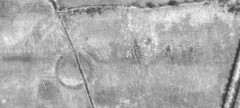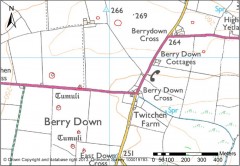Some of the most numerous and recognisable archaeological monuments in the National Landscape are the prehistoric barrows that once dominated the high ground, many of which are protected as Scheduled Monuments of national importance. These burial mounds covered a grave or graves, and are frequently found in groups known as barrow cemeteries. Most barrows are dated to the earlier part of the Bronze Age, approximately 3000 to 5500 years ago, following the Neolithic period when agriculture supplanted hunting and gathering as the primary means of subsistence.
Barrow on the skyline at Welsford. Photograph: Stephanie Knight
The barrows at Bursdon Moor, Welsford and Berry Down have long been recorded, and aerial survey has been able to add some detail to their more recent history, recording the impacts of changes in land management on the condition and survival of these monuments (for example MDV107 MDV108, MDV110, MDV14666).
Ringwork on Welsford Moor in 1946, showing the impact of ridges from deep ploughing. RAF/3G/TUD/UK/158 5121 19-APR-1946. English Heritage (RAF photography).
More of a surprise was the cluster of four previously unrecorded probable barrows near Ettiford (MDV103149). These were visible as pale soilmarks, probably the material from mounds levelled many years ago, that had been disturbed again and brought to the surface by the plough in more recent years.
Many other newly recorded barrows, normally single mounds close to barrow groups, were also identified during the survey. The possible barrow mound (MDV102339) close to the well-known Gallantry Bower (MDV72), on the cliff edge near of Clovelly, is one example. Could there once have been more barrows here that have succumbed to coastal erosion over the millennia? Or is there a different explanation for this mound: part of a more recent parkland feature maybe. Other examples of newly identified earthwork mounds or cropmarks of probable barrows include several at Berry Down (MDV103215, MDV103207 & MDV103214).
Barrows at Berry Down visible on aerial photographs (in red). Newly recorded features are in the north-east. © Crown Copyright and database right 2013. Ordnance Survey 100019783. NMP mapping © English Heritage.
Thanks to these discoveries we can better appreciate how this part of the North Devon coast may have appeared when there were many more burial mounds on hilltops, ridges and crests. It is possible to imagine swathes of the horizon peppered with these knolls and visible from sea and land, and wonder at the reasons for their placement in these prominent locations – to see or be seen? To place the dead in an exalted position, or perhaps for the living to make their stamp on a newly agricultural landscape?


